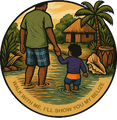Unearthing the Maya: Discoveries in Belize Since Independence
Walk With Me… I’ll Show You My Belize.
In 1981, Belize became an independent country.
At the same time, archaeologists were uncovering the stories of an even older nation—the civilization of the ancient Maya.
From monumental cities hidden beneath jungle canopy to precious artifacts buried for centuries, each discovery since independence has deepened our understanding of who the Maya were—and how their legacy shapes Belize today.
Here’s a look at what researchers have found over the past four decades, and why it matters.
🗓️ 1981–1999: Foundations and Rediscovery
The first decades after independence were a time of ambitious excavations and foundational research.
✅ Caracol
In the mid-1980s, archaeologists Arlen and Diane Chase began systematic mapping and excavation at Caracol, deep in the Maya Mountains.
- Teams uncovered massive temples, plazas, and elite tombs.
- Discoveries showed Caracol was the largest Maya city in Belize, rivaling Tikal in power.
- Hieroglyphic texts recorded alliances, conquests, and royal dynasties.
These early findings rewrote Belizean history, proving Caracol was not a remote outpost but a thriving metropolis.
✅ Cahal Pech
In the late 1980s and 1990s, excavations at Cahal Pech revealed something remarkable:
- Evidence of continuous settlement as early as 1200 BC, making it among the oldest Maya sites in Belize.
- Discovery of Cunil-phase ceramics, defining the region’s earliest pottery traditions.
- Elite burials with jade ornaments and imported goods.
This work positioned Cahal Pech as a critical site for understanding how May,a civilization began.
✅ Lamanai
Archaeologists continued work at Lamanai, famous for its occupation spanning nearly 3,000 years.
- Excavations documented Postclassic and Spanish colonial structures, including churches built atop Maya temples.
- Findings showed how the Maya adapted through conquest, trade, and missionization.
✅ Nim Li Punit & Lubaantun
In the 1980s–1990s:
- Nim Li Punit’s large carved stelae were studied and conserved.
- Lubaantun was mapped, confirming its unique dry-laid architecture and connection to coastal trade.
These early projects laid the groundwork for the discoveries that would follow.
✅ Lamanai
At Lamanai, archaeologists continue to uncover:
- Domestic areas that show continuous occupation from the Preclassic through Spanish rule.
- New data on how the community persisted despite regional collapse.
✅ Other Findings
Beyond the big cities, surveys and excavations have:
- Identified hidden ball courts, ceremonial platforms, and causeways in the Belize River Valley.
- Clarified settlement patterns that link small villages to large urban centers.
🌿 Why These Discoveries Matter
Since Belize’s independence, every new find has added another piece to the story:
✅ Connection
- Showing how ancient Belizeans built trade networks and political alliances.
✅ Resilience
- Revealing how Maya cities rose, fell, and adapted.
✅ Identity
- Giving Belizeans a deeper sense of cultural heritage that predates colonial history by millennia.
💬 A Personal Reflection
My first discovery of Maya pottery didn’t happen at a big archaeological site—it happened right in Placencia.
When I was young, someone showed me a piece and explained what it was. As I got older, I started walking into the bush on my own. I still remember the feeling of surprise when I realized the Maya had walked these same shores.
At first, it was hard to believe. Growing up, I didn’t think of Placencia as a place with ancient history. But as I learned more, I understood the Maya revered water, which is probably why there weren’t large settlements along the coast itself.
Sometimes, while exploring, we’d come across little patches of broken pottery. I was naive back then—I even broke a piece in two, just to see how easily it would snap.
Over time, though, my respect for these things grew. They were simple pieces of clay, but they survived longer than any house or road.
Years later, I was thrilled to see some of these artifacts whole again, cleaned and displayed where people could appreciate their real value.
Belize’s independence marked a new chapter in our national story—and in a way, it sparked a new era of rediscovering the civilizations that came before us.
Walk with me, and I’ll show you the Belize that’s still emerging from the jungle, one discovery at a time.
📚 Sources and Further Reading
- Chase, A. F., Chase, D. Z., et al. (2014). Ancient Maya Regional Settlement and Inter-Site Analysis.
- Institute of Archaeology Belize – NICH.
- Awe, J. J., et al. (2016). Excavation of a Royal Tomb at Xunantunich.
- Healy, P. F., & Awe, J. J. (1995). Preclassic Maya Occupation at Cahal Pech.
- Garrison, T. G., et al. (2018). Lidar Analysis at Caracol and Other Maya Sites.

